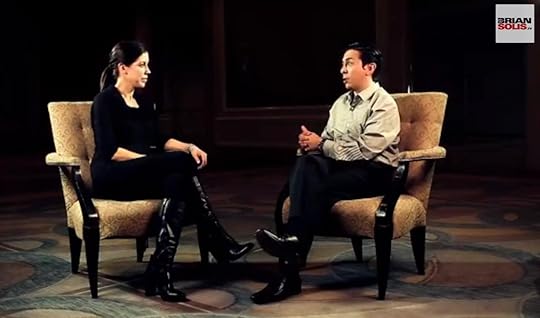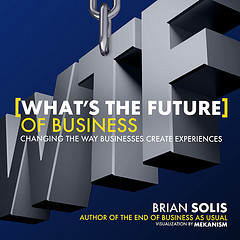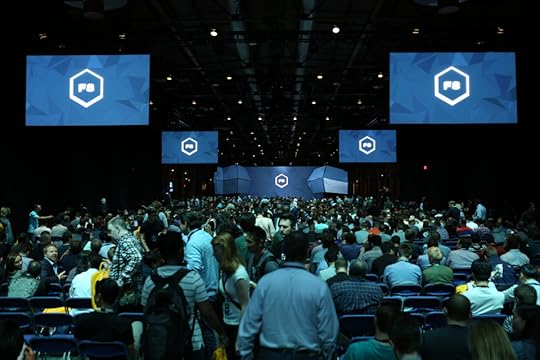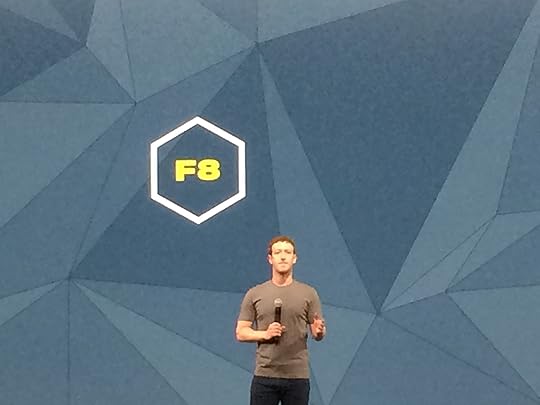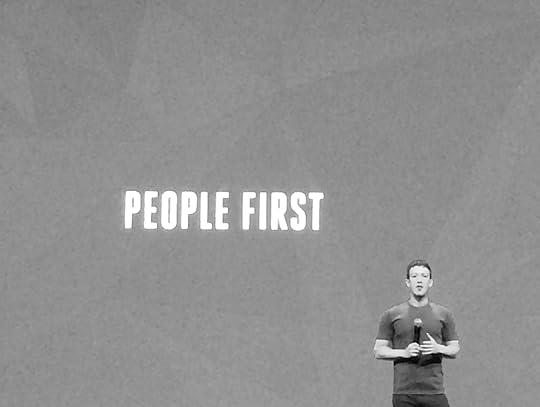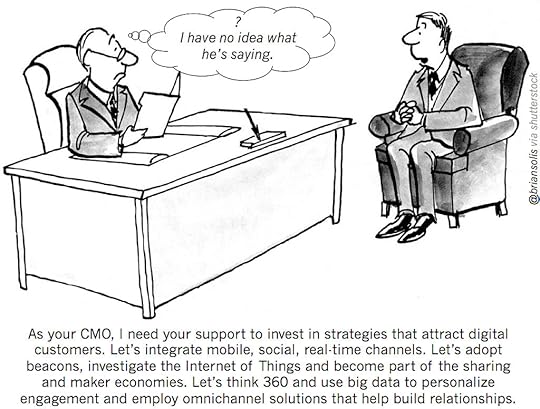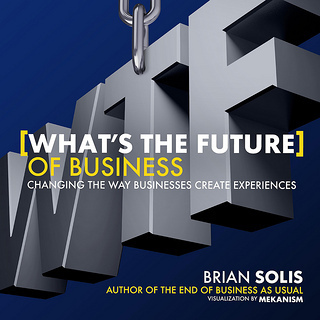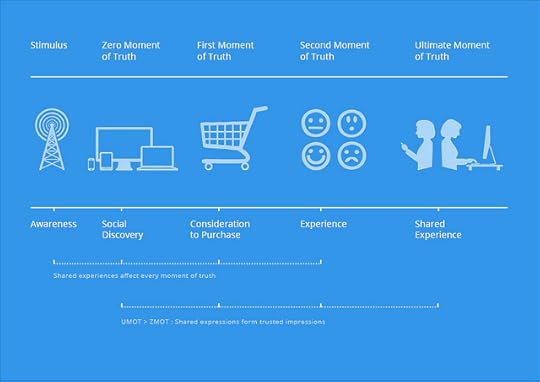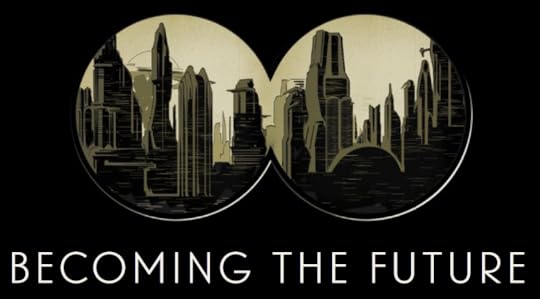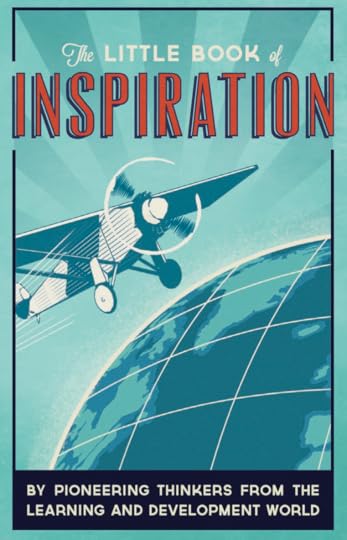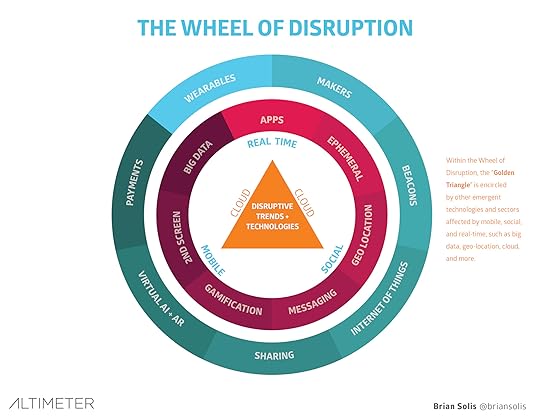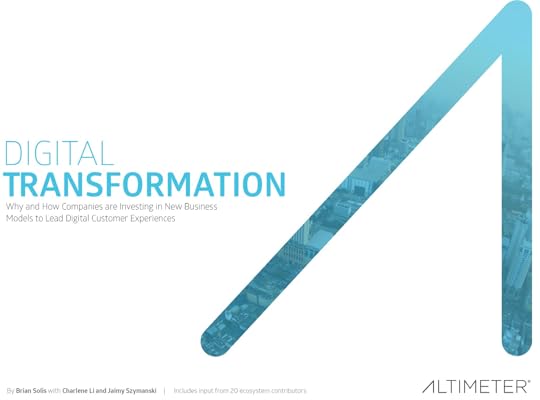Brian Solis's Blog, page 111
May 12, 2014
Guiding the Customer Journey
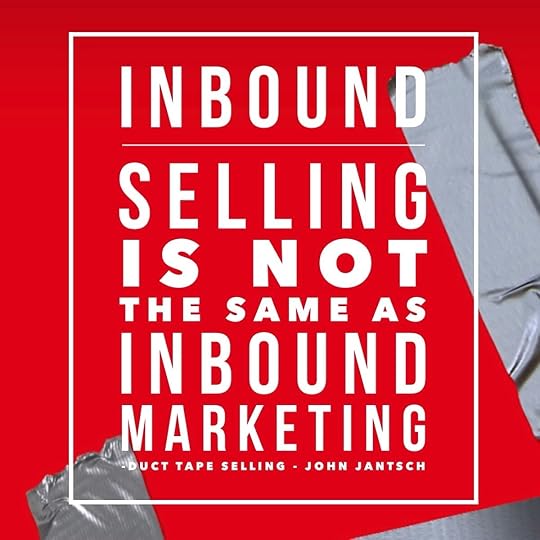
Guest post by John Jantsch is a marketing consultant, speaker and author and the founder of the Duct Tape Marketing Consultant Network. His latest book, Duct Tape Selling – Think Like a Marketer, Sell Like a Superstar is available online and in bookstores May 15.
Just a few years short years ago marketers were still heavily focused on broadcasting their message to create demand for their products and services.
Today, a kinder, gentler form of marketing called inbound marketing relies primarily on the creation and distribution of content in an effort to “be found.”
The foundation of the inbound approach is based to use heaps of content to draw people into you marketing funnel. And, while this has proven effective, many marketers simply interpret this to mean you create more demand by creating more content.
The problem with this thinking is that it’s really just the same old approach polished up with more information.
Today, marketing is about guiding a journey that the buyer wants to take rather than forcing them into the journey that fits our business model.
People don’t really need more information, they need insight, they need guidance and they need an experience that allows them to behave like they want to behave.
So, in many ways the future of marketing is less about creating demand and more about understanding and organizing behavior.
Over the years I’ve identified seven behaviors that most buyers desperately want to experience on their way to becoming loyal customers. Organizations that get this and create and organize opportunities for people to experience these behaviors at any point along the journey will win.
I’ll warn you that the journey is not always as direct and orderly as most marketers would like. Our job as marketers is to help buyers travel an often-crooked path that allows them to:
Know – They want to give permission to the companies they want to know
Like – They want to learn to like and respect companies that might be addressing their needs in a way that makes sense to them
Trust – They want to see that their friends and others they relate to have come to trust certain organizations for a variety of reasons
Try – They want to be able to prove to themselves that buying from certain organization won’t make them look foolish
Buy – They want to discover that there are companies that make the buying experience as awesome as the marketing experience
Repeat – They want to develop ties to organizations they can count on and that allow them to forget about other options
Refer – They want to have such a remarkable experience with organizations that so exceed their expectations they are compelled to share with the world how smart they are
If organization are to address these behaviors, marketing, sales and service must participate as one in guiding the relationship. The traditional silo walls must come down. Sales must participate earlier in the buyer’s journey and stay later. Service must become more social and marketing must learn how to personalize content while bringing front line sales people into the creation of messaging and positioning.
May 8, 2014
ASCAP and the Great Pandora Battle Where Artists and Musicians Pay the Price
Guest post by Monica Corton (@momusing), Executive Vice President, Creative Affairs & Licensing Next Decade Entertainment, Inc.
I spent many hours fielding questions and having conversations with songwriters about the recent win by Pandora in the ASCAP rate court. Mostly, the songwriters wondered why there was a battle in the first place and why ASCAP lost. Performance rights licensing (the right to publicly play/perform a song on the radio, television, the Internet, large venues etc.) is one of those areas that songwriters love, but often know little about. They love that the check comes in the mail on a quarterly basis like a miraculous gift and some even call it “mailbox royalties.” They rely on this money heavily even though many would not be able to describe how it is generated or what the rules are in governing the two major Performance Rights Organizations (PROs), ASCAP and BMI.
The Pandora battle revolves around this governing issue. ASCAP and BMI are membership associations which each represent over a half a million songwriters and music publishers in the field of performance rights licensing. ASCAP and BMI each function under consent decrees entered into with the U.S. Justice Department. The current consent decrees require that ASCAP and BMI must grant a license to any potential company or service that wants one. They do not have the right to say “no” to any potential licensee.
If, after they negotiate with any licensee — in this case, Pandora — and the licensee does not like the rates proposed by ASCAP or BMI, the licensee or the PRO has the right to go to federal court in New York to set the rate. This is exactly the tack that Pandora took and what has led us to this current situation. In court proceedings, it is the PRO’s burden to demonstrate that its proposed rate is “reasonable,” but the consent decrees provide no standards for determining “reasonableness.” The ASCAP Rate Court, through Judge Cote, has been consistently ruling against ASCAP since she began her tenure as the sole judge responsible for setting ASCAP license fees in 2009, rejecting the comparable licenses ASCAP has proffered as benchmarks for gauging the reasonableness of its fee proposals and accepting instead the licenses relied upon by Pandora and other ASCAP licensees.
What is particularly upsetting about all of this is the monetary facts revolving around Pandora. The license that Pandora has been functioning under since it entered into its original agreement in 2005 with ASCAP was at a rate of 1.85% of Annual Revenue, with the combined rate for all of the PROs totaling 4.3% of Annual Revenue. This is slightly more than traditional radio broadcasters pay for their ASCAP licenses, and commensurate with what other streaming services had been paying. However, services like Spotify and the new iTunes Radio pay significantly higher rates, ranging as high as a combined 10% of Annual Revenue. Further, the rate that Pandora pays the record labels for the master rights (the artists recording of a particular song) is in the range of 50% of Annual Revenue. Yes, you read that right….the songwriters have been fighting Pandora for them to pay 4.3% of Annual Revenue when Pandora pays the record labels 50% of Annual Revenue for the use of the master recordings of those same songs.
When Pandora complains that they are paying too much in royalties, which is their constant battle cry, the problem is they are paying a huge rate to the record labels. However, they have no recourse or leverage to reduce the rate they pay to the record labels because the labels function independently and their rates for services like Pandora have been determined by another governmental entity, the Copyright Royalty Board. The only royalties that Pandora has access and leverage to reduce are the songwriter royalties because of the way the consent decrees function.
The court costs that ASCAP has paid in fighting Pandora over their streaming rate come somewhere in the range of $5 to $9 million. Pandora likely has paid equivalent legal costs in their battle. Imagine if Pandora hadn’t gone to court over the combined PRO rate of 4.3% and had put that money — at the low end, say $5 million — into paying music publishers and songwriters a fair rate, the rate other streaming services are paying. Maybe then, Tim Westergren, Pandora’s CEO, who loves telling the press how much he adores musicians and songwriters, could honestly say that he is helping them with his streaming music service rather than what he has truly done, which is to almost single handedly upend the entire structure of the performance rights licensing system.
How did Westergren affect the performance rights licensing structure? The music publishers disagree with Judge Cote’s rate of 1.85% of Annual Revenue. In fact, the music publishers thought the combined PRO rate of 4.3% was also too low. The only way to get a higher rate is to pull the digital rights licensing away from the PROs’ control and make direct deals with digital services. This would allow the music publishers not to be governed by the consent decree in matters dealing with digital performance rights licensing. Some of the major music publishers and independent music publishers were in this process of pulling their digital rights with the PROs and EMI Music Publishing, Sony/ATV Music Publishing and Universal Music Publishing even negotiated direct deals with Pandora as they were the first music publishers to pull their digital rights licensing from the PROs. There had been a six month waiting period before any publisher could pull digital rights from ASCAP or BMI.
This process was moving forward for many publishers and then Pandora went to the ASCAP and BMI rate courts, asking those courts to rule that the publishers’ rights withdrawals did not apply to digital services like Pandora that had applied for licenses under the consent decrees. Both rate court judges ruled that the music publishers could not pull just one set of licensing rights (e.g., digital rights) from either ASCAP or BMI. The judges said if the music publishers wanted to license directly, they would have to pull all performance rights licensing from the PROs. No music publisher wants to do that.
Now, the PROs, the music publishers and others are asking the Department of Justice to agree to change the consent decrees so that it is clear that digital rights licensing can be pulled from the PROs. This will mean all digital companies, including Pandora when its current license is up in 2015, will have to negotiate with multiple music publishing companies either to get their services up and running, or to continue to offer their digital music services, because they won’t be able to clear digital performing rights at the PROs alone if the music publishers withdraw their digital rights. It will add a whole new level of rights clearance issues and liability to the process because the lawyers for these new digital companies will have to engage in these direct deals and ensure that they are covered for all of the music repertoire in their client’s digital services.
Before this rate battle began between ASCAP and Pandora, there was no question that all of the music publishers were being represented by the PROs for digital rights licensing.
The future seems precarious to the music publishing/songwriter community. The BMI rate court has yet to take up the Pandora royalty rate issue. If the PROs and the music publishers are successful in modifying the consent decrees, they will have a business solution for getting a higher rate, but it really isn’t a solution for the health and development of building new digital music companies and services. I firmly believe none of this would be happening if Pandora had been a good player with ASCAP. They created this situation and then Judge Cote complemented their bad moves with a totally unworkable decision.
I was at a publisher meeting recently, and the presenter gave some startling figures. He said that last year, Tim Westergren took out over $15 million dollars in stock options for Pandora (the highest amount he could extract in any given year). At the same time, Pandora paid ASCAP a little over $11 million in royalties for access to the entire ASCAP repertoire for the entire year. If this is true, or even slightly exaggerated then how does the guy who owns Pandora receive millions of dollars more in money in one year than all of the ASCAP songwriters and music publishers whose music was featured on his service in that very same year? When you look at it from this perspective, you can understand why there is such an outcry from the songwriter/music publishing community.
The music publishers and the PROs want a workable solution with Pandora and all the digital companies, but they cannot sit idly by and not receive a fair market value for their songwriter’s works in the digital arena. It’s a wild west in licensing right now, what I find so sad is…. it didn’t have to be.
Photo of Saxophone player by Shutterstock
May 6, 2014
Investing in Social Networks to Earn Influence and Reciprocity
On this special episode of Revolution, we meet Porter Gale, former VP of Marketing of Virgin America, advisor to exciting startups and business ventures, avid speaker, and also the author of the best-selling book, Your Network is Your Net Worth. Porter is someone whom I personally admire and have also had the good fortune to work with over the years.
With Porter, no matter what she’s working on, everything begins and ends with people. She shares her recipe for success in her new book and also with us here.
The idea of measuring the existing and potential value of a brand, or a person for that matter, by the nature and activity of its network or community is fascinating. To me, there are two ways to look at this…1) the net worth of the community as it exists and 2) its valuation based on what it could be. If we measure value based on the network effect of community engagement, often we see how conversations, listening, participation transcend online borders to cause desirable effect or positively change behavior. This only becomes increasingly resonant and effectual the more you invest in it and also focus it.
Everything begins with a shift in perspective. You must have the ability to teach but also the ability to learn. She’s both a mentor and a student. I love that about Porter. As incredible as she is, no matter how much in demand she is, she makes time for her communities. Personally, I could do better in that arena.
Here, Porter shares that the secret to relationships is collaboration…the more sharing, the better the outcome. It’s also equally important to listen. In fact, the best listeners, those that hear and respond in a way that’s empathetic, are among the best conversationalists (and strategists). Why? Because the reward for doing so is reciprocity…and that’s as human as it is priceless.
Please take a moment to watch this episode of Revolution:
Subscribe to BrianSolisTV here.
May 1, 2014
Facebook Evolves from Social Network to Social Ecosystem
Every so often, Facebook hosts its f8, a conference in San Francisco aimed at developers, media, and partners. This year, in front of an audience of 2,500+, Facebook introduced its vision for the next year and beyond. With Mark Zuckerberg kicking things off, Facebook introduced a dozen or so new products organized into three including Facebook’s update to Login, which gives people more control over the information they share with apps, Anonymous login, which offers a way for people to log in to apps without sharing personal information from Facebook with developers, and the Audience Network, which allows advertisers to easily extend their Facebook campaigns into other mobile apps.
The theme of f8 and also Facebook’s intentionally limited vision at the conference focused on three pillars…
1) Build
2) Grow
3) Monetize
The goal was to help developers expedite time to market, amplify visibility in the app world, optimize user experience and increase the value of their apps by plugging into the Facebook ecosystem. And by leveraging (still not used to using this word as a verb) Parse, a mobile app development platform acquired by Facebook in 2013, developers will have an unprecedented springboard toward market acceleration and consumer prevalence.
f8 2014 Announcement Summary
At f8, Facebook’s quantity and quality of announcements was notable. While aimed at developers, the implications of course significantly impact consumers, brands, and advertisers.
Let’s run through the list of Facebook’s news organized by its Build, Grow, Monetize focal point…
Build
The new Facebook Login: Letting people select what information to share with apps
Anonymous Login: A way for people to log in to apps without sharing personal information from Facebook with developers
Improved stability: A two-year stability guarantee for our core developer products
App Links: Making linking between apps easier
Parse updates: We updated Parse pricing to make building apps less expensive, and introduced tools for developers to build apps with Parse that work offline.
Grow
Message Dialog: Letting people share content from apps with friends through Facebook Messenger
Mobile Like Button: Like the Pages or content of individual apps through a native, mobile Like button
FbStart: A new program to help mobile startups grow through a package of resources and tools provided by industry leaders
Send To Mobile: An easy way for people to send an app to their phone after visiting a web site and logging in with Facebook
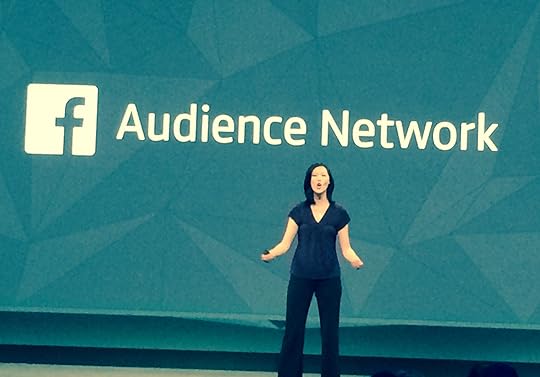
Facebook’s Deborah Liu introduces Audience Network at f8
Monetize
Audience Network: Developers now have a new way to effectively monetize mobile apps
Was f8 a 10?
If you judge success by audience response, the series of cheers and applauds that followed each announcement was certainly encouraging. While each announcement is important in its own right, in aggregate, they represent something far more profound.
The new “big blue” of the social economy has just grown up from a global social network with 1.2 billion users into a full-fledged social ecosystem. As Mark so called it, Facebook aims to build a “cross-platform platform.”
What does that mean?
It’s another way of saying social ecosystem.
What’s that mean?
In simpler terms, it means that Facebook as a platform is becoming incredibly portable and universal in pursuit of ubiquity.
Whether or not people are actually in Facebook at any one moment, with developers building apps upon the network of new tools, Facebook users carry their digital life with them. As a “cross-platform platform,” Mark’s vision is that developers can carry the power and appeal of the social graph seamlessly across IoS, Android, Microsoft, and others.
Take a look at Facebook’s list of new products again and what follows will make even more sense.
What Google search is to AdWords, what surfing and cookies are to ad targeting and re-targeting, Facebook’s social graph and social expressions are emerging as an omniscient index of personal connections and preferences. Now, developers, brands, and anyone with something to say or sell, can find people based on psychographics not just demographics as long as they’re willing to 1) pay Facebook directly or indirectly for it and most importantly 2) think thoughtfully about who it really is that they’re trying to reach and what makes them both unique and well-qualified to hear from you.
In many ways, like Twitter, Facebook is moving toward an Interest Graph and away from a straightforward social graph. Users will not only discover new content, apps, and ads based on who they know but additionally by what they like and express inside and outside of the network. And while that isn’t exactly new, the cloud for which this data resides has now been packaged, productized and presented to the market for experimentation.
Indeed, Facebook is still a social network. That’s its edge of the wedge play.
But the rest of the wedge, and its new revenue generating pillars include:
- Mobile
- Social Data
- Data as a Service
In a way, this is all very 1984. But at the same time, we as users have more control than ever before to fine-tune the signal of content and marketing that finds us. At the same time, to actually reach us, developers and marketers have to rethink their approach to grab our attention, pique our curiosity, and reward us for our time. In turn, we’ll reward our suitors with the very things they value. See, this isn’t just business, it’s personal. This is what sets Facebook apart from Google. It’s a more natural approach using a human algorithm rather than just a sophisticated technological algorithm.
Best of all, what Facebook did well at this year’s f8 was lead by example. With each of the company’s announcements and overall, the company itself demonstrated how to build, grow, and monetize.
Connect with me: Twitter | LinkedIn | Facebook | Google+ |Youtube | Instagram
April 29, 2014
Stop Talking About Technology and Start Designing Experiences
As Joe Pine and Jim Gilmore wrote in the Experience Economy: Work Is Theater & Every Business a Stage, the future of business is less about products and more about creating experiences. That’s right. You’re no longer in the product business. Products are a by-product of experiences you set out to create. Products are also social objects that spark desirable relationships between you and customers and also among customers.
The future of business is experiences.
One year after launching What’s the Future of Business (WTF): Changing the Way Businesses Create Experiences, I had the opportunity to tell the story behind the book and why experiences are…everything. I joined #MMchat hosted by Jeff Ashcroft (@TheSocialCMO), a weekly marketing chat on Twitter dedicated to helping CMOs and senior marketing strategists learn how to change their businesses.
I wanted to share the conversation with you here to reveal a more personal side…the intentions, decisions, and stories behind #WTF:
- Why did I focus on experiences?
- How exactly are experiences the future of business?
- What was my inspiration for designing the book the way I did?
You’ll notice that each question and answer is less than 140 characters…
Question 1: #WTF have you been doing for the past year+? #MMchat
The launch has been equally exhilarating, challenging + insightful. The book has done very well. It’s been a hustle though #MMchat
With each book, it gets harder, not easier, to compete for attention and also my share of $15.
Everyone is so busy these days…competing for mindshare in the moment and the future at the same time is humbling.
Tell us a bit more about #WTF. What was the inspiration for the book?
I am fascinated by experiences and how in a connected world, it is shared experiences that define our relationships.
I believe that shared experiences are driven from emotion and less about transactions.
Engagement is about creating experiences. Experiences are about expressions and not impressions. What should ppl feel and say?
I wanted to write a book that was an experience to demonstrate the purpose and possibility of being thoughtful at a higher level.
I set out to make a print book matter in a digital economy. I studied UX + was really thoughtful about the message I wanted to send.
The result…#WTF became an analog app where print is now arguably more effective than its digital counterpart.
If I could do this for a book, imagine what you can do with your product, service, or company.
Curious, does a book that’s been out for a year seem old in a digital economy?
Yes and no. A book takes time to produce. It’s not part of the real-time world we live in. It’s part of slow media.
I try to write books that are timeless-regardless of tech or trends. But even posts I wrote 6 weeks ago are “oldies but goodies.”
I wish I could take away the dates of my greatest works. People automatically think they’re old when they’re still the best.
I love book’s title. Tell us the story behind it, how you came up with #WTF & how you got that on the cover!
My last book was The End of Business as Usual. What’s the Future is about “what’s next.” half-empty vs half-full.
The fun part though is that “What’s the Future…” was intentional so that I could use the #WTF acronym 
Getting #WTF on the cover was easier than I thought. @WileyBiz was very supportive. You’ll notice it’s muted on the cover though.
The subtitle is very provocative, ‘Changing the way businesses create experiences.’ Why experiences?
Experience is everything. We think too much about products, services, brands, and transactions. We often miss what people feel!
We need to create experiences. Start with what people should feel…think…share. The future of branding is experience architecture.
In the book, you focus on the MOTs (The Moments of Truth). You claim there are 4. Can you walk us through the first moment?
The Zero Moment of Truth aka ZMOT is what Google introd as that moment when someone enters the discovery. Here they “Google it”
What happens in a world when Google isn’t the 1stst step in ZMOT? What if you YouTube or a review site is first? That day is here.
In a world of shared experiences, I’d take videos vs. websites. Websites suck on mobile phones.
Besides…Websites are written for execs who approve copy & not written for customers in their language or for their context/intentions :/
I want to hear from real people like me with real experience that match my intentions not marketers or spokespeople. #amiright?
In #WTF, you introduce the UMOT, The Ultimate Moment of Truth. Please share what it is and why it’s important.
The First Moment of Truth (FMOT) and the Second (SMOT) deserve a mention. FMOT = when someone is *about* to make purchase.
SMOT=the experience someone has when they become a customer. Experiences never end though. Experiences last throughout the lifecycle.
The Ultimate Moment of Truth (UMOT) is that moment when someone shares their experience.
UMOT is the future of branding. People already share today but they do so without our influence.
UMOT = the next person’s ZMOT. Shared experiences are the expressions that define the impressions and actions of other customers.
Something key to remember though is that we tend to confuse #connectedcustomers with ourselves. We project our actions upon them.
In many ways we are AND are not our customers. Yet we make decisions+investments as if we “get” them. Much is counter intuitive.
Just because you do something a certain way doesn’t make it “the” way. Same is true for execs who see things differently.
In my research, I’ve found that the next step leads to #digitaltransformation. “What would my digital customer do?”
You can download my latest research on #digitaltransformation here.
It’s our time to define the experience we want people to have and then share and reinforce it in all we do, say and create.
You can read the entire Twitter transcript here.
Connect with me: Twitter | LinkedIn | Facebook | Google+ |Youtube | Instagram
Image Credit: Shutterstock
April 24, 2014
Curiosity Didn’t Kill the Cat, It Unleashed a Lion: Cultivating Tomorrow’s Leaders Today
Guest post by social impact journalist and filmmaker Melissa Jun Rowley (@MelissaRowley), creator of the upcoming series “Magic Makers.”
Earlier this week, I was talking with a friend of mine who sold a fashion tech company in the early 2000s — before social media spawned copycat startups left and right, before TechCrunch made rockstars out of hot, young founders, and before corporations were seeking new ways to engage customers as forever faithful, digital brand ambassadors.
“There are times when I feel like I’m really putting myself out there, and taking a leap, but in hindsight I’m merely taking baby steps and trying to take calculated risks, so calculated that they’re not even risks,” I shared. “I’m basically playing it safe.”
“Unless you’re walking through a dark alley filled with killer monsters, playing it safe is the dumbest thing you can do,” she said. “If you’re really curious about something, you can’t pussyfoot around the water. You have to dive in.”
Her words struck a sharp chord with me, and got me thinking about the people I admire most—the ones out there taking risks, daring to innovate with the intention of changing consumer habits, and dancing like no one is watching. Most of them are between the ages 14 and 19.
This isn’t coincidental. Teenagers today are different than Millennials and older generations. Teens have never known a time before the Internet. Growing up amid significant tech innovation and political revolutions unfolding via social media, teenagers are are exceptionally globally aware and they are constantly asking questions. Not only are they asking questions, they’re creating solutions.
About a year ago, I read a story about a 16-year-old boy who invented a noninvasive, inexpensive way to detect pancreatic cancer. His name is Jack Andraka. His invention is 100 percent accurate. Jack introduced me to Adora Svitak. At 16, she’s already an accomplished author and activist. When she was 12, she spoke at TED about what adults can learn from kids. A few weeks later, I met a 17-year-old by the name of Easton LaChapelle. Easton used a 3D printer in his bedroom to build a robotic prosthetic arm designed to be controlled by brainwaves.
Later, I met Mariah Reyes, a dream interpreter who started a clothing line from recycled trash. I asked to share her greatest passion with me and she said, “As a country we’re going through a collective shadow, a collective fear that confines us from doing what we really want to do, and from becoming who we really came here to be. But we can come together and be a community. We can be demonstrators. We can think, declare and manifest change.” She’s 16 years old.
Not only are these young people prime examples of the most informed, connected generation in history, they are unabashedly, unequivocally unafraid to fail, which is why they’re so original. These kids think and they play. They collaborate, and they come up with good ideas just crazy and imaginative enough to work. They take risks. They don’t know any other way doing things.
This kind of human ingenuity is of the utmost importance to the fabric of our society for multiple reasons. In 1970, the top three skills required by the Fortune 500 were reading, writing and arithmetic. In 1999 the top three skills in demand were teamwork, problem-solving and interpersonal communication. We need schools to develop these skills in young people, and we need educators to encourage curiosity and risk taking so this mindset will ultimately transfer to businesses.
That being said, there is a new generation of educators who are inventing ways for students to learn through their own curiosity. Rather than spoon-feeding information, these teachers are prompting students and then stepping aside so the students can teach themselves, while discovering their own unique talents. There are high schools in New York City that do this. They’re a part of the Internationals Network, and they report a higher graduation rate than the city’s average for the same populations.
What would happen if more businesses took this cue? What if more brands created space for creating new products and influencing behavior? Not every company can have a Google X, creating future technologies such as space elevators and self-driving cars. But the brands that continue trotting on a safe terrain will never reach a higher plateau.
At the end of the day teenagers are young. They still have all of their dreams in front of them. They don’t have all the answers any more than any other age group. But it’s time we ask them to be a bigger part of the conversation about improving business and global development, so they can help us build solutions.
Image Credit: Shutterstock
April 22, 2014
Becoming the Future
I’m pretty passionate about changing how we teach in order to create a bridge between analog and digital generations. I recently contributed a short chapter to The Little Book of Inspiration and I wanted to share it with you here.
In an age where knowledge is more accessible than ever, how do we create engaged workplace learners that are inspired to go out and discover the answers themselves? Reed, in conjunction with Learning Technologies and the Learning & Skills Group, put that question to 13 leading experts and L&D thinkers. I was invited to contribute to the mix. This short book is our response and it is now available as a free download.
Becoming the Future
The future of learning is constant.
Technology is evolving faster than we can master each innovation. What isn’t advancing as quickly however is our philosophy on how we learn and, even more, how we teach. Innovation isn’t just about technology. Innovation begins from within.
To quote famed novelist Leo Tolstoy…“Everyone thinks of changing the world, but no one thinks of changing himself.”
While I teach, no matter how much I learn, I am forever a student. I understand that it is what we learn that inspires us to see how to change the future for how others learn and teach as well. Sometimes we just need a change in perspective…a change in how we see the world to shape how the world sees us. I am in constant pursuit of accepting who I am today and investing in who I want to be tomorrow. But to grow, we need substance and direction.
It takes vision and courage to take the unknown next steps in a direction that most do not follow.
The distance between who you are and who you want to be is separated only by your aspirations and actions.
Dream:
Uncover what is meaningful to you in the long term and what you aspire to become.
Do:
Do the things that bring your dreams and your vision to life…even if it’s iterative.
It’s the sum of the parts that contributes to the whole and the outcome.
Deserve:
As you act, react, and persevere, you discover the secret to defining your own destiny follows the laws of physics, for every action there is an equal and opposite reaction.
The more you do, the more opportunities you unlock. You earn what you deserve.
This is your time to shape the way we learn and teach!
Connect with me: Twitter | LinkedIn | Facebook | Google+ |Youtube | Instagram
Contributors include:
Clive Shepherd
Nigel Paine
Paul Stoltz
Paul Matthews
Deborah Frances-White
Guy Claxon
Donald H. Taylor
Jane Hart
Euan Semple
Harold Jarche
David Wilson
Jim Kirkpatrick
April 16, 2014
Beaconizing the Brand Experience
Guest post by Gib Bassett, Global Program Director, Consumer Goods, Teradata
There’s no question that the shopping journey has been disrupted by consumer behavior in online, social media and mobile channels. What’s less certain, especially within the branded consumer products industry, is the best way to serve this now commonplace “connected consumer.” The pursuit of this answer, and the quest to learn more about connected consumers, is commonly referred to as “digital transformation.”
Consumer products manufacturers in food, beverage, health and beauty, and apparel segments are like well-oiled machines, down to the execution of sales with retail partners. Marketing has almost always exclusively supported sales at retail by creating brand awareness. In the past, this took the form of print and television advertising; today it also includes creative served in a more targeted fashion via online display. In spite of this, sales growth remains an industry-wide challenge and marketing is under a microscope.
Brands also are very much engaged in email, website and social media campaigns. Like display advertising, these tend to be an extension of the “marketing as retail support” model. We’re all familiar with email and mobile coupons, website or SMS promotions, mobile apps, and other demand-centric tactics.
Truths
All of this activity overlooks how digital channels have changed shopper behavior. Google’s Zero Moment of Truth and Brian Solis’ Ultimate Moment of Truth illustrate how out of date an in-store and shelf-only view of consumer decision making has become. Also, consider a couple of consumer goods “industry truths”:
- There are a lot more SKUs than in the past from both brands and retail private labels. So consumers have more choices while brands face the challenge of standing out from the crowd. Plus, price still rules for most purchase decisions.
- Consumers tend to buy the same items repeatedly. While coupons help increase consumption, they do so at the expense of already slim margins. The inverse problem is that introducing a new product in pursuit of sales growth faces less than favorable odds at getting added to the shopping list or being purchased on impulse.
More competition and difficult-to-influence shopper behavior makes for a poor fit with display advertising. Awareness and (maybe) a click are the extent of interactions with the consumer.
Conversations
In order to drive demand amid a market of connected shoppers requires engagement with consumers in an ongoing dialog at many points along the purchase journey. The programs succeeding today attempt brand conversations with individual consumers about how even the most utilitarian product lives within and adds value to their lives. Content is not about product features or price – it’s about the individual consumer. Tactics like coupons, promotions, and mobile apps form part of the story developed to convey brand value.
The difficulty in doing this well lies in the details; how do you create relevant messaging for individual consumers that encourages dialog with the brand and sharing among friends, at a scale equivalent to the millions of households reachable via a television spot?
Analytics-driven multi-channel marketing has long served other business-to-consumer industries able to close the loop on their marketing to affect a measurable sales transaction. It’s therefore easily justified.
CPG marketers don’t have this luxury. At best, sales information comes from anonymous and aggregate data some retailers share in the name of volume and category growth. This is why the “easy” digital route is online display media supported with tactics.
Content Beacons
Visionary CPG companies recognize the value of applying multi-channel marketing techniques to the challenge of connecting with consumers without a line of sight into directly correlated sales transactions. They seek to enable their brands to tell stories and measure consumer engagement as a means of optimizing marketing content investments.
Millions are spent on content creation and propagation across many channels and media. Multi-channel marketing concepts can be fitted to this alternate use case by helping brand marketers understand the contribution of content investments to an engaged audience of individual consumers. It’s like placing iBeacons on branded content such that marketing spend can be optimized around the messaging that connects best with consumers. Metrics such as open rates and website visitor dwell times become indicators of content quality comparable on a relative basis.
It takes a blend of informed creative brilliance and technology enablement to pull this off – key is informed. To these ends, it’s essential to reign in the insights digital channels capture to fuel a profile of individual consumers that lives, grows, and evolves just like the person it describes. These insights help both agencies and brand marketers inform brand storytelling with knowledge of their consumers beyond superficial characteristics. In this way, you could say consumers help write the story.
Changing Course
Re-prioritizing around direct, data driven brand marketing isn’t as difficult as it seems. Much of the data to seed an initial snapshot of individual consumers exists; it’s just scattered in various places inside and outside the company and needs to be brought together in a single place. The harder part is implementing the processes necessary to ensure that the contributors to this insight (agencies) adhere to some level of standards with respect to data formats and collection frequency.
Agencies can also be a source for justifying a move to more direct consumer connections. Even brands within the same company tend to work with different agencies or services companies, each of whom gladly bill for repetitive technology development that could be standardized. Without hampering the creativity at the heart of successful brand storytelling, standards can drive significant costs out of website development, data collection, consumer database work, email marketing and mobile messaging.
The upside to brands is more useful and consistent analytics to measure the contribution of content to audience engagement. As shopping decisions shift to an Ultimate Moment of Truth where consumer-generated content becomes the “moment,” brands should find the ability to optimize content around an engaged consumer a valuable commodity.
Download the report about how companies are pursuing digital transformation in detail here.
Image credit: Shutterstock
April 8, 2014
Report: Digital Transformation and the New Customer Experience
We’re under attack! Social, mobile, real-time, cloud, big data…it’s coming at us all at once! Rather than miss out, many brands are jumping from trend to trend as a way of staying relevant in an increasingly digital market.
Facebook, Twitter, Youtube, Foursquare, Instagram, Pinterest…we’re covered. We have and had a strategy for a while now.
Mobile. Yep, we’ve got an app for that…plus we’ve got adaptive and responsive web design that makes old sites new again!
Snapchat…our brilliant strategy vanishes in 5,4,3,2,1.
Jelly? We’ve got the answer.
Whisper, Secret…shhh, don’t tell anyone, but we’re already marketing there.
There’s a difference though between marketing AT people in new channels and learning about their behavior, values, and expectations to optimize their digital experiences and introduce mutually-beneficial outcomes.
Social, mobile, and real-time strategies are not enough. These disruptive technologies are merely just the beginning of a still shaping era of connected consumerism.
Each in its own right is significant affecting how business is done. But customer behavior and expectations, and that of employees for that matter, continue to evolve. And, the list of disruptive technologies that’s pushing business leaders and processes out of their respective comfort zones is far more exhaustive and constant.
When we stop chasing trends and fighting for technology and marketing strategies in the moment, we can appreciate that our view of technology and its aggregate impact on markets is far more massive that we initially realized.
- Wearables
- Maker Movement
- Beacons
- Geolocation
- Internet of Things
- Sharing Economy
- Gamification
- Big Data
- Second Screen
- Virtual AR/AI
- Payments
Instead of reacting to technology trends at departmental levels, some progressive, brave and tireless strategists are investing in a more comprehensive campaign of digital transformation. The goal is to invest in informed models that help businesses recognize opportunities, overcome challenges, and make decisions to stay in step, if not ahead of digital customers. Beyond social, mobile, and real-time, digital transformation is in fact, the next big thing in customer experience and ultimately how business is done.
Over the last year, my Altimeter Group colleague Jaimy Szymanski and I set out to learn how digital technologies are impacting customer behavior and in turn how businesses are responding. Through a series of interviews with digital strategists and executives at some of the world’s leading brands, we specifically explored the role of how this new customer behavior along with the relentless onslaught of disruptive technology is influencing how organizations evolve.
The result is our new report…”Digital Transformation: Why and How Companies are Investing in New Business Models to Lead Digital Customer Experiences.” And, we’re proud to announce that it is now officially available for immediate download here!
Defining Digital Transformation
Altimeter Group defines digital transformation as:
The re-alignment of, or new investment in, technology and business models to more effectively engage digital consumers at every touchpoint in the customer experience lifecycle.
In our research, we learned that digital transformation represents the quest to understand how disruptive technology affects the overall customer experience. The investment in change is a direct result of businesses seeking to adapt to this onslaught of disruptive technologies as they affect customer and employee behavior. As technology becomes a permanent fixture in everyday life, organizations are faced with an increasing need to update legacy technology strategies and supporting methodologies to better reflect how the real world is evolving.
The need to evolve is becoming increasingly obligatory.
We do not tackle enterprise-wide digital transformation in this report. Instead, we conducted our research through the lens of customer experience to learn how companies are adapting to new consumerism. The way today’s consumers use screens and what they expect to accomplish does not mirror traditional customers of the past; their values are shifting, and how they make decisions no longer aligns with a traditional funnel model. Expectations are reshaping engagement and, ultimately, the way their relationships with companies unfold. From social and mobile, to customer insights and journey mapping, to IT and training, digital transformation improves how businesses see their customers and create value throughout their lifecycle.
In our research, we found that understanding the digital customer experience is one of the primary catalysts for businesses placing substantial investment in digital transformation. Change must begin with noting the considerable differences between traditional customer strategies and those required to engage and nurture relationships with digital customers. It creates a sense of urgency and affects not only the roles and objectives of marketing, social media, web, mobile, and customer service, but also their intentions and how these typically disparate groups work toward harmony. The result ultimately makes businesses relevant in a digital era while growing opportunities and profits, as well as scaling efficiently in the process.
As companies begin to invest in digital transformation, they are realizing promising benefits.
Benefits of Digital Transformation
Updated company vision
The company vision is modernized and humanized, which earns support from digital customers.
Thriving culture of innovation
This effort creates buzz within the organization and inspires a company culture of innovation and the ability to innovate in product and service development.
Improved customer journey
Customers continue naturally every step of the their journey, which improves conversions and outcomes.
Greater competitive advantage
Businesses build competitive advantage that executives recognize.
Increased internal collaboration
Collaboration significantly improves between business functions.
Empowered workforce
Leadership and employees feel empowered through education.
Improved efficiency
Decision-making and processes become more efficient across departments.
Deeper data analysis
Better understanding of what/where data is across the organization, which translates into the ability to infer insights and deepen customer analysis to prove ROI.
Increased customer conversions and loyalty
A true 360-degree, seamless customer experience contributes to increased conversions and customer loyalty.
While digital transformation means different things to different people, its concept becomes a mantra for earning relevance and establishing leadership in a digital economy.
Change begins with you…
Please take a moment to download the report now!
Connect with me: Twitter | LinkedIn | Facebook | Google+ |Youtube | Instagram
Report: Why and How Businesses are Investing in Digital Transformation and the New Customer Experience
We’re under attack! Social, mobile, real-time, cloud, big data…it’s coming at us all at once! Rather than miss out, many brands are jumping from trend to trend as a way of staying relevant in an increasingly digital market.
Facebook, Twitter, Youtube, Foursquare, Instagram, Pinterest…we’re covered. We have and had a strategy for a while now.
Mobile. Yep, we’ve got an app for that…plus we’ve got adaptive and responsive web design that makes old sites new again!
Snapchat…our brilliant strategy vanishes in 5,4,3,2,1.
Jelly? We’ve got the answer.
Whisper, Secret…shhh, don’t tell anyone, but we’re already marketing there.
There’s a difference though between marketing AT people in new channels and learning about their behavior, values, and expectations to optimize their digital experiences and introduce mutually-beneficial outcomes.
Social, mobile, and real-time strategies are not enough. These disruptive technologies are merely just the beginning of a still shaping era of connected consumerism.
Each in its own right is significant affecting how business is done. But customer behavior and expectations, and that of employees for that matter, continue to evolve. And, the list of disruptive technologies that’s pushing business leaders and processes out of their respective comfort zones is far more exhaustive and constant.
When we stop chasing trends and fighting for technology and marketing strategies in the moment, we can appreciate that our view of technology and its aggregate impact on markets is far more massive that we initially realized.
- Wearables
- Maker Movement
- Beacons
- Geolocation
- Internet of Things
- Sharing Economy
- Gamification
- Big Data
- Second Screen
- Virtual AR/AI
- Payments
Instead of reacting to technology trends at departmental levels, some progressive, brave and tireless strategists are investing in a more comprehensive campaign of digital transformation. The goal is to invest in informed models that help businesses recognize opportunities, overcome challenges, and make decisions to stay in step, if not ahead of digital customers. Beyond social, mobile, and real-time, digital transformation is in fact, the next big thing in customer experience and ultimately how business is done.
Over the last year, my Altimeter Group colleague Jaimy Szymanski and I set out to learn how digital technologies are impacting customer behavior and in turn how businesses are responding. Through a series of interviews with digital strategists and executives at some of the world’s leading brands, we specifically explored the role of how this new customer behavior along with the relentless onslaught of disruptive technology is influencing how organizations evolve.
The result is our new report…”Digital Transformation: Why and How Companies are Investing in New Business Models to Lead Digital Customer Experiences.” And, we’re proud to announce that it is now officially available for immediate download here!
Defining Digital Transformation
Altimeter Group defines digital transformation as:
The re-alignment of, or new investment in, technology and business models to more effectively engage digital consumers at every touchpoint in the customer experience lifecycle.
In our research, we learned that digital transformation represents the quest to understand how disruptive technology affects the overall customer experience. The investment in change is a direct result of businesses seeking to adapt to this onslaught of disruptive technologies as they affect customer and employee behavior. As technology becomes a permanent fixture in everyday life, organizations are faced with an increasing need to update legacy technology strategies and supporting methodologies to better reflect how the real world is evolving.
The need to evolve is becoming increasingly obligatory.
We do not tackle enterprise-wide digital transformation in this report. Instead, we conducted our research through the lens of customer experience to learn how companies are adapting to new consumerism. The way today’s consumers use screens and what they expect to accomplish does not mirror traditional customers of the past; their values are shifting, and how they make decisions no longer aligns with a traditional funnel model. Expectations are reshaping engagement and, ultimately, the way their relationships with companies unfold. From social and mobile, to customer insights and journey mapping, to IT and training, digital transformation improves how businesses see their customers and create value throughout their lifecycle.
In our research, we found that understanding the digital customer experience is one of the primary catalysts for businesses placing substantial investment in digital transformation. Change must begin with noting the considerable differences between traditional customer strategies and those required to engage and nurture relationships with digital customers. It creates a sense of urgency and affects not only the roles and objectives of marketing, social media, web, mobile, and customer service, but also their intentions and how these typically disparate groups work toward harmony. The result ultimately makes businesses relevant in a digital era while growing opportunities and profits, as well as scaling efficiently in the process.
As companies begin to invest in digital transformation, they are realizing promising benefits.
Benefits of Digital Transformation
Updated company vision
The company vision is modernized and humanized, which earns support from digital customers.
Thriving culture of innovation
This effort creates buzz within the organization and inspires a company culture of innovation and the ability to innovate in product and service development.
Improved customer journey
Customers continue naturally every step of the their journey, which improves conversions and outcomes.
Greater competitive advantage
Businesses build competitive advantage that executives recognize.
Increased internal collaboration
Collaboration significantly improves between business functions.
Empowered workforce
Leadership and employees feel empowered through education.
Improved efficiency
Decision-making and processes become more efficient across departments.
Deeper data analysis
Better understanding of what/where data is across the organization, which translates into the ability to infer insights and deepen customer analysis to prove ROI.
Increased customer conversions and loyalty
A true 360-degree, seamless customer experience contributes to increased conversions and customer loyalty.
While digital transformation means different things to different people, its concept becomes a mantra for earning relevance and establishing leadership in a digital economy.
Change begins with you…
Please take a moment to download the report now!
Connect with me: Twitter | LinkedIn | Facebook | Google+ |Youtube | Instagram


